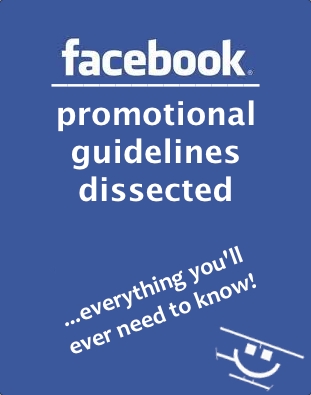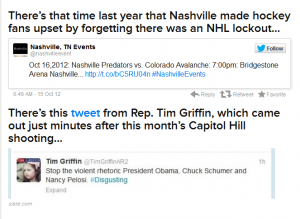Archive for October, 2013
Twitter Gaffes…Beware of Autotweeting and Scheduled Tweets!
October 15th, 2013 • COMM464, EMarketing
How a company inadvertently ends up committing a social media gaffe when attempting to navigate through social media is always humorous and no so infrequent as people think it may be. With brands able to autotweet their messages, there have been many gaffes in the past. These are some popular gaffes that have been sourced from Buzzfeed.
Yesterday, Twitter announced on its blog that marketers can now schedule their tweets up to a year in advance if they use the company’s ad product! While this can help the company in planning its complex ad campaigns months in advance, as detailed above, there could be serious repercussions too.

Autotweets can turn out to be the bane of people’s lives too, not just those of brands. As a marketing and PR enthusiast, I love listening to Guy Kawasaki talk and recently, he was in the news for failing to shut off his regular stream of autotweets in the midst of the Boston Marathon tragedy. In fact, many people criticised him for trying to “hawk his wares” when the nation is dealing with a tragedy.
But this was the story of 1 prominent person. What if this was a company, large or small, who had an active twitter base? Any errors in this realm can not only quickly reduce the precious follower count but also create a lot of negative press.
Also, scheduling many tweets, all advertorial in nature, can put off your audience who is looking to strike a conversation with you. They can unfollow you or worse, collapse your feed! Often ignored as a concept, collapsing a feed from a specific follower allows you to avoid seeing their posts unless you want to see them specifically. Also, autotweets could be seen as impersonal, unauthentic and unengaging- three words that could mean great harm to your brand!
Advertorials- The ads you like to read!
October 14th, 2013 • COMM464, EMarketing
Thinking about ads especially the banner ads in the mobile space often brings a sense of caution in me and I carefully make sure that I avoid clicking on the ads. I inadvertently do click them thanks to my “fat finger syndrome” but I soon after close the window and continue on with my browsing.
But what if there was an advertisement that I would seek out to read and would enjoy having it interspersed on the web page? What if this ad had the right tone and fit well with the content of the website. Such ads have been around for a long time and were called advertorials in the past. Now known as sponsored content or native advertising, this “signifies advertising that is meant to match the style readers are used to in the pages of their favourite publication or website”. Marketers partner with media companies to nestle their ad messages among that desirable content of the website.
But how does a website like Buzzfeed manage to use native advertising effectively but Gawker’s advertising is not appealing?


In my opinion, it comes back to following monitoring, listening and conversing procedures. Buzzfeed introduces ads only after carefully understanding what the audience converses about and what articles are popular with the audience. Also, in order to ensure that the advertising is authentic and effective, it has a dedicated team to make sure the branded content has the right tone. Transparency is also important: the advertised content is highlighted and advertiser’s name is mentioned.

Buzzfeed’s advertising model is this: it aids in creating content that looks like Buzzfeed editorial content and runs these sponsored ads on Buzzfeed.com. Because, these ads as mentioned previously are original, unexpected and authentic Buzzfeed’s sell is that its audience will share content around social networks, giving advertisers the much coveted “earned media.”
The only issue with this is that there is little scope for automation in this process. Curating ads and choosing the right set is a painstaking process in authentic native advertising as evidenced by the dedicated team that Buzzfeed maintains. But the returns are high and the ads are much more credible and have a potential to go viral if native advertising is used effectively.
What we need to know NOW about Facebook’s Promotions Guidelines! (this is good news)
October 3rd, 2013 • COMM464, EMarketing
Promotions through Facebook are going to get a whole lot more popular! On Aug 27th, when I was relishing the last few days of a sunny summer, Facebook changed its promotional guidelines that now makes it easier and potentially a whole lot less expensive (!!) for companies to run promotions through their Facebook pages!
On Aug 27th, an age old rule that allowed companies to run promotions only through a third party app was scraped and instead, now companies can run contests on their pages! So, now posting a status and asking its audience to “like” or comment on the post for a chance to win is allowed. This, in my opinion, is huge! Not only can small business now stop relying on the expensive third party developers to run their Facebook promotions, but with incentivising users to like their posts to win, there is a potential that a status update can now become viral or gain a lot of traction. Also, by asking customers to post their entries for contests on the page itself, you are earning content that is curated by the customers and is generally positive.

You still cannot however ask a consumer to tag a picture of themselves with the product to win. So while there are still a few rules in place, the playing field has now become a lot fairer for small businesses who early could not legally run promotions due to a lack of resources to hire a third party developer. Also, it is simpler for companies to run ads as well directly on their page. And finally, this relates to my previous post about brand consistency and the ensuing credibility and trust – many third party ad developers have an interface that is different than that of the brand and this inconsistency can lead to dramatically less customer engagement.

So will this be the end of third party apps? Shortstack CEO Jim Belosic certainly doesn’t think so and says that the merit of the third party apps lie in their ability to not only collect data but also leverage it for use in continuing marketing promotions. But at the end of the day, the biggest winner is Facebook itself which will undoubtedly see companies competitively create content on their news feeds to attract eyeballs and thereby greater consumer engagement.
One challenge though- Facebook shows only 500 likes for a post at a time so if a small pizza parlour runs a contest and gets 20000 likes and needs to choose one winner from all the likes submitted, how will the shop do this equitably? Is there any potential for consumer dissatisfaction?
Sources:
http://bit.ly/15Kl0k9
http://on.fb.me/182byF1
Run Easy!
October 2nd, 2013 • COMM464, EMarketing
Do you recognize the above slogan? If not, try this: There are two people in everyone. Do you recognize that? No? Finally, what about this: Just Do It. Yes, you are right, the third slogan has been Nike’s tagline for the past 15 years! The first two slogans, belong to Nike’s chief competitor Reebok who has changed its slogans 14 times since 1987! Little wonder then that you couldn’t recognize this!
How does this translate to profits? According to this article Nike successfully increased this brand share from 18% to 43% in the 10 years ending in 1998. This is just one small example of how brand consistency whether it be in the form of slogans or website design can increase a brand’s awareness and market share.
Brand consistency wasn’t a challenge before in companies who had one store front and one radio advertisement per week. However, with today’s multi channel marketing tools available at one’s disposal, it is easy to be inconsistent in messaging or interface when juggling these various tools. The picture below is a classic example of how the vast differences between an email picture and the website can rob the business of its credibility and potential sales. The traditional funnel mentions that prior to purchase, it is important that people can credibly evaluate their options and inconsistencies in the brand can only harm the brand.

The article however cautions that consistent messaging doesn’t mean identical messaging because then you are not exploiting the social media tool’s ability to give flavour to the brand. Instead standards should be put in place to ensure that key messaging is stressed in the same way in all the channels.
Storytelling and Social Media
October 1st, 2013 • COMM464, EMarketing
Personal, Authentic, Simple, Engaging and Inclusive- these are the five characteristics of a good brand story. While this formula may be easy to learn, it is difficult to put this into practice in today’s times. We today have a multitude of marketing means be it mass means of social media such as Facebook and Twitter or niche marketing means such as Foursquare. Hence the first challenge that companies face is to decide which means to use. Here, the Conversation Prism presented by Solis is useful. So, for example if a company wants to attract a large audience and wants to tell a story through the use of video, then looking at the prism, the company can choose to use YouTube.
Choosing a medium is the first step of brand story telling. The second step is to actually tell the story convincingly and consistently. Talking about convincing story telling, it is important to realize that engaging the consumers is the first step as described by Solis in his book Engage. For this, monitoring and understanding the audience either by means of the altimeter or social ladder is important.
To tell the story convincingly, it is important that everyone who has the responsibility of say, using the company’s twitter account to tweet out messages, has the same tone, voice and message. Conflicting messages because different people are tweeting leads to inconsistency and less value for the story as per this article.
This article talks about how good story telling can reap each dividends in the future: telling a good story through social media can easily be amplified by happy customers thereby increasing the amount of the much coveted earned media.
Story telling is key to marketing both offline and online and combining story telling with cost effective marketing means such as social media can only mean success for the brand in the long run case in point being Dunkin Donuts where people voluntarily shared pictures of the product after an initial attempt by the company.
